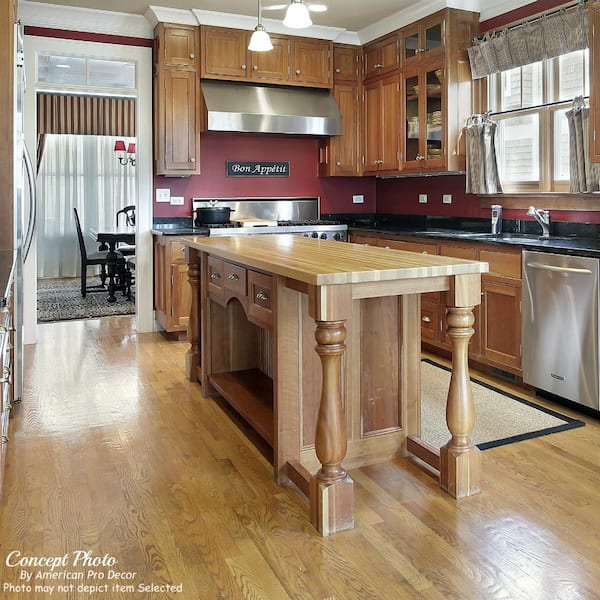Crucial Factors to Think About When Picking Legs For Cooking Area Island
Selecting the proper legs for a kitchen island includes a careful evaluation of numerous elements that can dramatically influence both capability and aesthetic charm. As we discover these elements, it ends up being clear that each choice can have far-reaching ramifications for the total kitchen area experience.
Product Options
When picking legs for a kitchen island, recognizing the numerous material choices is essential for achieving both aesthetic allure and architectural integrity (Legs For Kitchen Island). The option of product significantly influences not only the toughness of the island but also its general style and capability
Metal legs, typically made from stainless steel or functioned iron, add a commercial and modern-day feeling while making sure toughness and security. These materials are resistant to wear and can support significant weight, making them excellent for bigger islands.
An additional alternative is crafted materials, like MDF or plywood, which can be much more affordable while still providing a series of finishes. They might not supply the exact same level of security as strong wood or steel. Legs For Kitchen Island. Last but not least, materials such as acrylic or glass can create a modern appearance, though they may call for extra support to ensure security.
Inevitably, the choice of material for kitchen island legs must align with the wanted functionality and the total style of the kitchen area.
Style and Style

When taking into consideration design, the form and coating of the legs are crucial. Tapered legs can offer a sense of lightness and beauty, while thicker, much more robust legs can convey strength and stability. Additionally, the finish-- be it repainted, tarnished, or all-natural-- need to enhance the kitchen cabinetry and kitchen counter products to produce a unified look.
Furthermore, the design of the legs can also reflect individual preference. Custom-made or ornamental legs, such as those featuring elaborate carvings or special geometric shapes, can act as prime focus, including personality and character to the kitchen. Inevitably, the appropriate option will not just boost performance but additionally raise the aesthetic allure, making the cooking area island a standout function of the home.
Height Factors To Consider
Selecting the appropriate elevation for kitchen area island legs is essential, as it directly affects both functionality and convenience. The common height for a cooking area island normally ranges from 36 to 42 inches, straightening website link with typical countertop elevations. A 36-inch height is excellent for cooking and cooking, enabling comfy use of cooking area appliances and tools. Conversely, a height of 42 inches is typically favored for islands intended for bar seats, suiting taller stools and offering an informal dining experience.

It is also important to account for customers' preferences and elevations. Personalizing the height can ensure a comfy experience for all relative, making the cooking area island a much more functional and delightful area.
Weight Support
Making certain appropriate weight support for cooking area island legs is crucial for both safety and capability. The kitchen area island often offers multiple objectives, including food prep work, dining, and extra storage space, requiring a durable support framework. When selecting legs, it is vital to consider the total weight capacity needed based upon the island's intended usage and the products that will be put on it.
The choice of material for the legs plays a significant function in their weight-bearing capacities. Solid timber, metal, and durable compounds typically give exceptional toughness compared to lighter products. Furthermore, the style of the legs-- whether they are directly, tapered, or have a pedestal type-- can influence their capacity to distribute weight successfully across the framework.
Always speak with the maker's specs concerning load limits to ensure that the legs can sustain the desired weight without endangering safety and security. In recap, choosing kitchen area island legs with sufficient weight support is essential for developing a secure and useful culinary room.
Installment and Maintenance
Proper installment and maintenance of cooking area island legs are vital for ensuring long life and stability. This commonly involves safeguarding the legs to the island base using ideal fasteners, making certain that the legs are level and straightened.
Once set up, normal maintenance is essential to protect the honesty and appearance of the legs - Legs For Kitchen Island. For wood legs, routine cleaning with a moist fabric and application of appropriate wood polish can protect against dampness damage and preserve their coating. Metal legs may need a mild cleaning service to get rid of grease and grime, complied with by a completely dry cloth to stop corrosion formation
In addition, evaluate the legs frequently for indications of wear or damages, such as splits or loosened joints. Tightening up screws or screws as required can additionally lengthen the life-span of the legs. By sticking to these installment and upkeep techniques, homeowners can ensure that their kitchen island remains durable and visually appealing for years to come.
Conclusion

Aesthetic coherence is vital in picking the design and design of legs for a kitchen area island, as these aspects substantially influence the overall ambiance of the area. informative post Tapered legs can supply a feeling of agility and style, while thicker, extra durable legs can convey strength and stability.Choosing the suitable height for kitchen island legs is important, as it directly affects both performance and comfort. In summary, choosing kitchen area island legs with sufficient weight support is vital for producing a functional and safe culinary room.
In verdict, picking legs for a cooking area island requires cautious consideration of various factors, consisting of product choices, style, height, weight assistance, and installment.
Comments on “Change Your Kitchen's Appearance with Unique Legs For Kitchen Island Accessories”